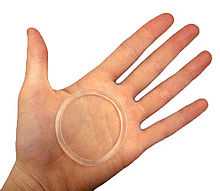Vaginal ring

NuvaRing
Vaginal rings (also known as intravaginal rings, or V-Rings) are polymeric drug delivery devices designed to provide controlled release of drugs for intravaginal administration over extended periods of time. The ring is inserted into the vagina and provides contraception protection. Leaving the ring in for three weeks slowly releases hormones into the body, mainly vaginally administered estrogens and/or progestogens (a group of hormones including progesterone). These hormones stop ovulation and thicken the cervical mucus, creating a barrier preventing sperm from fertilizing an egg. Worn continuously for three weeks followed by a week off, each vaginal ring provides one month of birth control. Several vaginal ring products are currently available, including:
A number of vaginal ring products are also in development.
Methods of use
General - Vaginal rings are easily inserted and removed. Vaginal walls hold them in place. Although their exact location within the vagina is not critical for clinical efficacy, rings commonly reside next to the cervix. Rings are typically left in place during intercourse, and most couples report no interference or discomfort. In many cases, neither partner feels the presence of the ring.
[2]
Rings can be removed prior to intercourse, but, in the case of the contraceptive Nuvaring, only for one to three hours to maintain efficacy of birth control.
- Estring - Estring is inserted into the vagina and left in place for three months, after which it is removed and replaced with a fresh ring.
- Femring - Femring is inserted into the vagina and left in place for three months, after which it is removed and replaced with a fresh ring.
- NuvaRing - NuvaRing is inserted into the vagina and left in place for three weeks, after which it is removed for a 'ring-free' week to allow menstruation to occur.
References
- ↑ Drugs.com - Progering
- ↑ FAQs on nuvaring.com
External links
|
|---|
| | Comparison | |
|---|
| | Behavioral | |
|---|
| Barrier and / or
spermicidal | |
|---|
| Hormonal
(formulations) | |
|---|
| | Anti-estrogen | |
|---|
| | Post-intercourse | |
|---|
| | Intrauterine device | |
|---|
| | Abortion | |
|---|
| | Sterilization | |
|---|
| | Experimental | |
|---|
| |
|---|
| | Description |
- Anatomy
- Physiology
- Development
- sex determination and differentiation
|
|---|
| | Disease |
- Infections
- Congenital
- Neoplasms and cancer
- male
- female
- gonadal
- germ cell
- Other
- Symptoms and signs
|
|---|
| | Treatment |
- Procedures
- Drugs
- benign prostatic hypertrophy
- erectile dysfunction and premature ejaculation
- sexual dysfunction
- infection
- hormones
- androgens
- estrogens
- progestogens
- GnRH
- prolactin
- Assisted reproduction
- Birth control
|
|---|
|
|
|
|---|
| | Androgen | |
|---|
| | Estrogen | |
|---|
| | Progestogen | |
|---|
| |
|---|
| | Description |
- Anatomy
- Physiology
- Development
- sex determination and differentiation
|
|---|
| | Disease |
- Infections
- Congenital
- Neoplasms and cancer
- male
- female
- gonadal
- germ cell
- Other
- Symptoms and signs
|
|---|
| | Treatment |
- Procedures
- Drugs
- benign prostatic hypertrophy
- erectile dysfunction and premature ejaculation
- sexual dysfunction
- infection
- hormones
- androgens
- estrogens
- progestogens
- GnRH
- prolactin
- Assisted reproduction
- Birth control
|
|---|
|
|

-solution.jpg)


